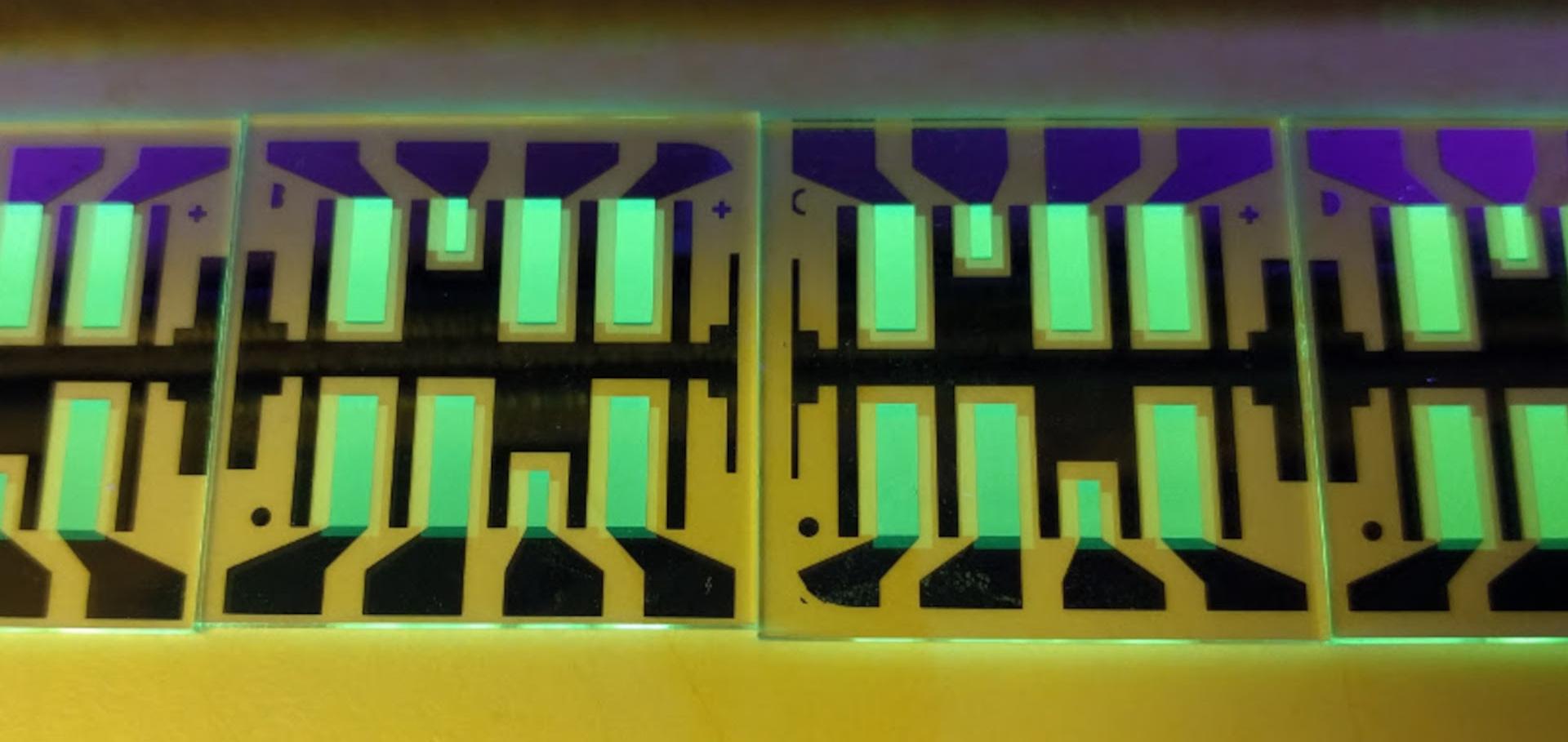Measurements of efficiency losses in blend and bilayer-type zinc phthalocyanine/C 60 high-vacuum-processed organic solar cells
Journal of Physical Chemistry C 116:31 (2012) 16384-16390
Abstract:
Losses of charge carriers, due to the interfacial charge recombination processes, in small molecule organic solar cells (SMOSCs) have been investigated under operating conditions. The devices consist of zinc phthalocyanine (ZnPc) as electron donor material and C60 as electron acceptor. The results obtained by using time-resolved techniques such as charge extraction (CE) and photoinduced transient photovoltage (TPV) have been compared to the measurements carried out with impedance spectroscopy (IS) and show good agreement. Significantly, much difference is observed in either the charge density distribution versus the device voltage or the charge carriers lifetime when comparing bulk heterojunction versus bilayer-type ZnPc:C 60 devices. The implications of the faster charge carrier recombination with the device fill factor (FF) and the open circuit voltage (V OC) are discussed. © 2012 American Chemical Society.Fermi level shift and doping efficiency in p-doped small molecule organic semiconductors: A photoelectron spectroscopy and theoretical study
Physical Review B - Condensed Matter and Materials Physics 86:3 (2012)
Abstract:
We study the mechanism of molecular doping of the organic small molecule N,N,N ′,N ′-tetrakis(4-methoxyphenyl)-benzidine (MeO-TPD) doped with the fluorinated fullerene C 60F 36 or the acceptor molecule 2,2 ′-(perfluoronaphthalene-2,6-diylidene) dimalononitrile (F6-TCNNQ). Varying the doping concentration, photoemission spectroscopy measurements show a comparable Fermi level shift for both dopants. The doping efficiency, defined as the ratio of free charge carriers (holes) to acceptors, is estimated from the depletion layer thickness in metal/intrinsic/p-doped structures. For low concentrations, we observe rather high doping efficiencies of up to 36% for C 60F 36, whereas for both dopants the doping efficiency strongly decreases with increasing doping concentration down to less than 10%. By numerically solving the charge neutrality equation using a classical semiconductor physics approach and comparing the results to the ultraviolet photoelectron spectroscopy data, we show that for very low concentrations doping is hindered by deep intragap states. In particular, the calculations can statistically explain the strong decrease of the doping efficiency for high doping concentrations. © 2012 American Physical Society.Correlation of π-conjugated oligomer structure with film morphology and organic solar cell performance.
J Am Chem Soc 134:27 (2012) 11064-11067
Abstract:
The novel methyl-substituted dicyanovinyl-capped quinquethiophenes 1-3 led to highly efficient organic solar cells with power conversion efficiencies of 4.8-6.9%. X-ray analysis of single crystals and evaporated neat and blend films gave insights into the packing and morphological behavior of the novel compounds that rationalized their improved photovoltaic performance.Phase separation analysis of bulk heterojunctions in small-molecule organic solar cells using zinc-phthalocyanine and C60
Physical Review B - Condensed Matter and Materials Physics 85:24 (2012)
Abstract:
To achieve efficient organic solar cells, donor and acceptor molecules are mixed in the photoactive layer to form a so-called bulk heterojunction. Due to molecular interactions, a certain degree of phase separation between donor and acceptor domains arises, which is necessary to achieve efficient charge extraction within the absorber layer. However, the mechanism that induces the phase separation is not fully understood and gaining detailed information about the molecular arrangement within these blend layers is quite challenging. We show that grazing incidence x-ray diffraction, combined with variable angle spectroscopic ellipsometry is a suitable way to investigate the molecular structure of blend layers in detail, consisting of a mixture of zinc-phthalocyanine (ZnPc) and C60 . The degree of phase separation within the blend layer is influenced by substrate heating during the co-evaporation of ZnPc and C60 and by a variation of the mixing ratio. The effect of different blend layer morphologies on optical and electrical device performance is investigated by solar cell characterization and mobility measurements. We find that the molecular arrangement of C60 provides the essential driving force for efficient phase separation. Whereas spherical C60 molecules are able to form crystalline domains when deposited at elevated substrate temperatures, no ZnPc crystallites are observed, although the planar ZnPc molecules are not randomly oriented but standing upright within its domains. Comparing specular and grazing incidence x-ray diffraction, we find that only the latter method is able to detect nanocrystalline C60 in thin films due to its polycrystalline nature and small sized nanocrystallites. Solar cell measurements show an increase in fill factor and external quantum efficiency signal for blends with enhanced phase separation, induced by higher substrate temperatures. However, grazing incidence x-ray diffraction measurements reveal that ZnPc and C60 already form separate domains in unheated ZnPc:C60 blends, which provide fill factors close to 50% in the corresponding solar cells. © 2012 American Physical Society.Degradation of Small-Molecule based OPV
Chapter in Stability and Degradation of Organic and Polymer Solar Cells, John Wiley & Sons (2012) 5


